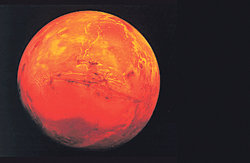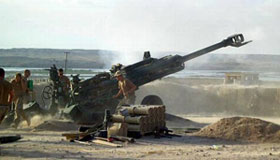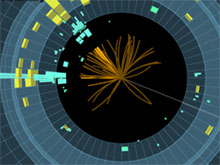July 2018 Science and Technology
Sakshi Education

- Underground lake detected on Mars
Using a radar instrument on an orbiting spacecraft, scientists have spotted appears to be a sizeable salt-laden lake under ice on the southern polar plain of Mars, a body of water they called a possible habitat for microbial life.
The reservoir they detected — roughly 20 km in diameter, shaped like a rounded triangle and located about 1.5 km beneath the ice surface — represents the first stable body of liquid water ever found on Mars.
The water in the Martian lake was below the normal freezing point but remained liquid thanks in large part to high levels of salts.
- Army to resume M777 trials
 The Army will resume the trials of the U.S.-made M777 Ultra-Light Howitzer (ULH) in Pokhran firing range.
The Army will resume the trials of the U.S.-made M777 Ultra-Light Howitzer (ULH) in Pokhran firing range.
The trials were suspended last September after barrel of a gun burst during firing.
In November 2016, India signed a deal with the U.S. government under the Foreign Military Sales (FMS) programme for 145 M777 guns at a cost of $737 million.
M777 Ultra-Light Howitzer
The M777 howitzer is a towed 155 mm artillery piece. It succeeded the M198 howitzer in the United States Marine Corps and United States Army in 2005.
The M777 is also used by the ground forces of Australia, Canada, India and Saudi Arabia. It made its combat debut in the War in Afghanistan.
- China to launch 300 satellites to provide worldwide low-orbit communications
China plans to launch 300 low-orbit satellites to provide worldwide communication services, with the first in the series to be launched later this year (2018).
The first in the 300-satellite array — known as the Hongyan constellation — is set to be launched by the end of this year (2018)
The Hongyan constellation is composed of more than 300 satellites, along with data processing centers, and will be built in three stages.
Once completed, the satellite communication network will take the place of the ground-based network and allow a mobile phone to be connected everywhere on the planet, either in a remote desert or at sea.
China is already developing BeiDou Navigation Satellite System (BDS) to rival America’s Global Positioning System, (GPS). Besides rivaling GPS, China uses BDS for its military applications to avoid dependence on GPS.
The new constellation will be the first group of low-orbit communication satellites designed and launched by China, enabling the country to better guide disaster rescue efforts
Why Low-orbit satellites?
Low-orbit satellites have stronger signals and a shorter signal delay than synchronous orbit satellites, which are 36,000 km above the equator.
- ISRO ropes in three partners to assemble 27 satellites
The Indian Space Research Organization (ISRO) has roped in three partners to help it assemble 27 satellites at a quick pace over the next three years.
ISRO's nodal satellites division URSC (U.R. Rao Satellite Centre) signed separate three-year contracts with Alpha Design Technologies P Ltd and its six consortium members; with defense public enterprise Bharat Electronics Ltd; and with Tata Advanced Systems Ltd, Hyderabad.
Each partner will work with the URSC to produce three small to medium satellites each year, or a total of 27 spacecraft by July 2021.
URSC-ISRO has inked pacts for outsourcing of spacecraft assembly, integration and testing [AIT] activities with multiple vendors.
URSC estimates a requirement of around 71 satellites till 2021. It means adding 12 satellites a year or one every month. In 2017, it made a record 12 spacecraft but is unable to cope with a growing demand from new applications. Around 35 Indian spacecraft are active in space and will need to be replaced as they expire over time.
URSC unit, ISRO Satellite Integration and Test Establishment or ISITE, will also provide three separate work stations for the three partners.
The space agency launches three types of satellites - for communication, Earth observation and navigation.
- Sea trials of Vikrant expected to commence by 2020
Sea trials of the indigenously built aircraft carrier, Vikrant, are expected to commence by early 2020
The ship was launched in August 2013 and presently, the main propulsion plant, power generation equipment, deck machinery and auxiliary equipment have been installed and integrated on board.
Outfitting of various aviation equipment, navigation and communication equipment, weapons and sensors are progressing.
- HSV1 virus linked to Alzheimer’s disease
Scientists have found evidence of a link between herpes infection and Alzheimer’s disease as well as the potential of antiviral in reducing the risk of the neurodegenerative disease.
A study by Taiwanese epidemiologists shows that Herpes Simplex Virus type 1 (HSV1) which infects most humans in their youth or later and remains in the body for life in dormant form within the peripheral nervous system leads to an increased risk of developing the disease.
Scientists believe that these safe and easily available antiviral may have a strong part to play in combating the disease in these patients.
- Sought Higgs Boson Detail Finally Confirmed
 The Higgs boson has finally been observed decaying into the particles called a bottom quark, six years after it was discovered. The reason for this delay was noise.
The Higgs boson has finally been observed decaying into the particles called a bottom quark, six years after it was discovered. The reason for this delay was noise.
The Higgs boson was discovered indirectly. Detectors didn’t spot it directly as much as spotted a few particles in the collision fray that could only have come from a decaying Higgs boson. These were two photons and particles called W and Z bosons.
The Higgs boson has a tendency to decay into pairs of a fermion and an anti-fermion Moreover, it is likelier to decay into heavier fermions than into lighter fermions because it interacts more strongly with the former.
The heaviest fermion is the top quark, but it is too heavy itself for the Higgs to decay into.
The next is the bottom quark – and theoretical calculations suggest the Higgs should decay into a bottom quark and anti-quark 60% of the time.
The third is the tau particle, which weighs almost half as much as the bottom quark and to which the boson decays only 6% of the time.
Evolution of Higgs Boson:
The announcement of its discovery was made in July 2012.
By knowing that the Higgs boson exists, physicists were able to ascertain that the theory pegged to this particle, which discusses how elementary particles get their mass, is valid. This is why Peter Higgs and Francois Englert were awarded the physics Nobel Prize in 2013.
- Technology Challenge Launched For Promoting Suitable Techniques for Cleaning of Sewers and Septic Tanks: MoHUA
The Ministry of Housing and Urban Affairs has launched a technology challenge for promoting suitable techniques for cleaning of sewers and septic tanks with the objective of eliminating the human entry into septic tanks/manholes etc.
The Ministry of Housing and Urban Affairs, which was entrusted with the task, has now launched the “Technology Challenge: Identifying solutions for cleaning of Sewerage Systems and Septic Tanks.
Objectives
Identify technological as well as business process innovations.
Endorse viable business models that are suitable for a different size, geographies, and class of cities.
Pilot test and handhold to scale the shortlisted technologies/solutions in select project cities.
Bridge the gap between innovators/manufacturers and beneficiaries- i.e. ULBs, citizens
- IIT Delhi Scientists improvise models to better predict storm surges
 Researchers at India Institute of Technology, Delhi, have come up with an improvised prediction model that promises to help make more accurate forecast of storm surges due to cyclone and other storms arising on the eastern flank of the country, in Bay of Bengal.
Researchers at India Institute of Technology, Delhi, have come up with an improvised prediction model that promises to help make more accurate forecast of storm surges due to cyclone and other storms arising on the eastern flank of the country, in Bay of Bengal.
Many models are available to predict the effect that wind speed can have upon storm surges. However, across the world scientists use a model called Jelesnianski cyclonic wind model predominantly due to its simplicity.
The researchers at IIT-D wanted to verify if this model can be used in the Indian context also. They tested it out to predict the winds that formed during several cyclones that occurred in the Bay of Bengal since 2010 -Jal (2010), Thane (2011), Phailin (2013) and Hudhud (2014). It was found to underestimate the magnitude and was inaccurate in predicting the direction.
The scientists dwelt on the equations that go into the making of the model and have developed a modified version, which could make predictions that were in tune with the actual speed and direction.
The elevation of water in the sea is determined by factors like shape and geometry of coast, depth of water in the sea, tides and the wind that generates waves. The wind speed along with its direction is important as it directly affects the generation of storm surges.
Storm surges are a major threat to lives of people in coastal areas, apart from the damage they can cause to property and biodiversity. India has a more than 7,500 km long coastline encompassing nine states which are highly vulnerable to damage by the elevation of sea level due to tropical cyclones that emerge from the Bay of Bengal and the Arabian Sea. Incidences of storm surges are increasing and are expected to increase due to climate change. Accurate prediction of the intensity of storm surges is, therefore, a research priority as it can help in planning the disaster management strategy.
- Agni-V to be part of nuclear arsenal soon
India’s longest-range ballistic missile, Agni-V, will be inducted into the nuclear arsenal very soon, according to official sources.
The Intermediate Range Ballistic Missile (IRBM) with a range of over 5,000 km can reach most parts of China.
In June, the canisterised variant of the missile was successfully test-fired by the user, the Strategic Forces Command (SFC). A few more user trials are planned.
The Agni series of missiles constitute the backbone of India’s nuclear weapons delivery, which also includes the Prithvi short-range ballistic missiles and fighter aircraft. The submarine-based nuclear arsenal, which assures second strike capability in the face of the proclaimed no-first-use policy, is taking shape.
- Nipah transmission from bats: National Institute of Virology (NIV) Pune
Pune’s National Institute of Virology (NIV) confirms that the virus was found in fruit bats captured in Kozhikode. Out of the 51 Pteropus giganteus bats sampled by the NIV team from the Kozhikode epicentre of the outbreak, 11 had genetic material from the Nipah virus.
These portions of the viral genome were detected through a test called Reverse Transcriptase Polymerase Chain Reaction, and were 99.68% similar to the virus in patients. This indicates strongly that the bats were the carriers in the Kerala outbreak.
- Scientists to develop antibiotics for drug-resistant bacterial infections in newborns
(ICMR, GARDP, World Health Organization, Drugs for Neglected Diseases initiative)
ICMR has initiated a joint research with Global Antibiotic Research and Development Partnership (GARDP) to develop new antibiotics for drug-resistant bacterial infections in newborns.
GARDP is a joint initiative by the World Health Organization (WHO) and the Drugs for Neglected Diseases initiative (DNDi).
Increasing rates of bacteria resistance to existing treatments are very high.
Hospitalized newborns and infants at high risk of developing drug-resistant hospital-acquired infections, so there is a need to fight against the infections.
Published date : 13 Jul 2018 05:12PM



















